 I try to make it a habit to pick up books that will serve as reference material. I ordered a copy of “African Rifles and Cartridges” by John Taylor, complete with a forward that was written in 1948.
I try to make it a habit to pick up books that will serve as reference material. I ordered a copy of “African Rifles and Cartridges” by John Taylor, complete with a forward that was written in 1948.
The jacket wasn’t the best and I started thinking I had just purchased an old third grade primer, but I picked it up, read a little, put it down, came back to it again…. The coverage of early big game cartridges is extensive, including the transition from black powder to nitro based smokeless.
The book is just an interesting chunk of history without: distortions of poor memory, misinterpretation, political correctness, and sloppy story iteration. The illustrations are great; simple but excellent ink drawings, including cutaways, covering every cartridge of any significance. I was left with the feeling not much of real importance has happened in the world of heavy guns and ammo since around 1937.
If it weren’t for these relics, there might not have been super flat shooting magnums today. I get a kick out out of reading current articles that rip on Weatherby, suggesting the belted cartridge is dead and newer cartridges, like those designed by Lazzeroni are now in vogue. The Lazzeroni is based on the .416 Rigby that has been with us since the 1930’s.
The answer is, there is nothing new, except maybe the .300 Remington Ultra Mag, which is a compromise cartridge designed to accommodate the 700 series action. Smaller than the .378, larger than the .300 Mag – a niche just waiting to be filled ? Now if we could just get someone to release an updateed version of the 4 bore.
 After constantly running through wire brushes for my RCBS primer pocket cleaner at a cost of $5.95 per brush, I figure there had to be a better way without investing in a “Primer pocket, empty case prep, motorized, blah, blah, blah”.
After constantly running through wire brushes for my RCBS primer pocket cleaner at a cost of $5.95 per brush, I figure there had to be a better way without investing in a “Primer pocket, empty case prep, motorized, blah, blah, blah”.
Dremel makes both a carbon and stainless steel 1/8″ shank wire brushes. $1.95 at discount hardware suppliers and they seem to last a lot longer. Have to save money someplace to offset the cost of those $10,000 rifles.
Converting to single stage for more precise reloading
 This past week, and the week before, and the week before that, and… I may have mentioned, in passing, that an auto progressive press may not be the most ideal piece of equipment for short volume or high capacity cartridges. This week, I thought I would do something different and actually address the problem.
This past week, and the week before, and the week before that, and… I may have mentioned, in passing, that an auto progressive press may not be the most ideal piece of equipment for short volume or high capacity cartridges. This week, I thought I would do something different and actually address the problem.
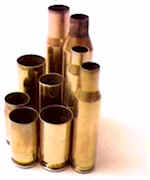 So I’ve split my reloading activity into two parts, auto progressive, and single stage. Under the auto progressive category I’ve placed:
So I’ve split my reloading activity into two parts, auto progressive, and single stage. Under the auto progressive category I’ve placed:
.357 SIG .357 Magnum .223 Remington
.40 S&W .44 Magnum .30/30 WCF
.45 Auto .222 Remington .243 Winchester
I can load these in volume, without jams, errant powder charges and missed primers. I can run my scale spot checks with uneventful results with any type of ball powder, or short granule extruded powder. Unless a problem requires more immediate attention, I can disassemble and clean the press at 500 round intervals, or 1,000, depending upon how sloppy I’ve been with powder and case lube and trying not to intentionally combine the two.
If the cases need trimming and/or primer pocket work, as a result of frequent use or heavy charges, or if there is anything else that would cause me to run less than 3 full progressive reloading steps, they fall out of auto progressive and drop into the next group.
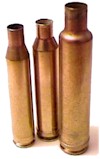 These guys are the basis for my “next group”:.25-06, 7MM Remington Mag and the .338-378 Weatherby. At 60, 70 and 120 grains approximate capacity- left to right, they exceed what a press mounted powder measure can consistently meter.
These guys are the basis for my “next group”:.25-06, 7MM Remington Mag and the .338-378 Weatherby. At 60, 70 and 120 grains approximate capacity- left to right, they exceed what a press mounted powder measure can consistently meter.
In addition, a rotating shell plate full of the 7MM Mag and the .338-378 cases has enough mass to overcome the indexing detent ball and spring that hides between the shell plate and the shell plate holder. This position overrun causes primer feed jams and poorly centered bullets.
A progressive press is a compromise to precision, even if only because everything on the press has to rotate and index into position. So slop exists in the shell plate holder, the shell plate, the index rod and bushing, and the powder measure’s case detection push rod.Longer cases accentuate the problem, showing up as non-uniform COL or bullet/case concentricity problems.
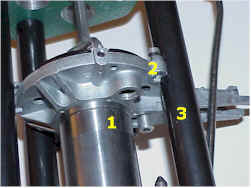 The Ammo Master ram (#1) is 1 1/2″ in diameter, compared to almost 1″ for the Rock Chucker. But the load is carried at the shell plate holder in line with the cartridges case centerline, over two inches from the centerline of the ram.
The Ammo Master ram (#1) is 1 1/2″ in diameter, compared to almost 1″ for the Rock Chucker. But the load is carried at the shell plate holder in line with the cartridges case centerline, over two inches from the centerline of the ram.
There are three 3/4″ bars supporting the die holder, but only one (#3) provides the only lateral support to the shell plate holder.
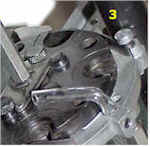 This might be a better shot of the shell plate holder and how it is retained by the guide bar on the front of the press.
This might be a better shot of the shell plate holder and how it is retained by the guide bar on the front of the press.
Also in the picture is the hex rod that drives the press during auto progressive operation and controls indexing. For small cartridge operation it seems fine, but I think it’s just too light for large cartridges. The press also has an alloy frame.
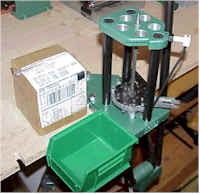 I thought I was going to write a spiffy article on an Ammo Master conversion kit that converts from a decent progressive press to single station operation. At less than $60 I was going to be able to leave my Ammo Master in place, swap to single station operation for my group 2 stuff, not take up the space required for a second press, and make some decent ammo.
I thought I was going to write a spiffy article on an Ammo Master conversion kit that converts from a decent progressive press to single station operation. At less than $60 I was going to be able to leave my Ammo Master in place, swap to single station operation for my group 2 stuff, not take up the space required for a second press, and make some decent ammo.
I waited a week, a box showed up and, from its small size, I started wondering how many parts the assembly had been broken into for shipment. There was a small note inside the box, under a couple of bags of bulk bullets which read, “Here are your 185 grain .45 auto bullets, hope you like them. By the way, that conversion kit has gone obsolete, went backordered, and will show up….well…never.”
That didn’t seem right. I called RCBS, who indicated they had kits in stock, without a price listed, suggesting the conversion kit had indeed gone, causing me to use the word “indeed” for the first time ever in anything I’ve written.
RCBS asked if I could call back on Monday to unravel the mystery, thought about it for a moment, then suggested Tuesday – it seems Monday is usually a busy day for them. Owning RCBS equipment, and speaking to their customer service department, is like having an irritating brother-in-law, and having to remind yourself he’s married to your sister.
 I broke down and ordered a single station press from Lock Stock & Barrel , a Rock Chucker. I have no idea what a Rock Chucker is, or how the words came together to identify a reloading press, but it sounds pretty reasonable. A very beefy piece of cast iron.
I broke down and ordered a single station press from Lock Stock & Barrel , a Rock Chucker. I have no idea what a Rock Chucker is, or how the words came together to identify a reloading press, but it sounds pretty reasonable. A very beefy piece of cast iron.
The Rock Chucker has a smaller diameter ram than the Ammo Master, but it is a lot more rigid as a result of fewer moving parts and pressure being directed to the center of the ram rather than the outside edges of a rotating shell plate.
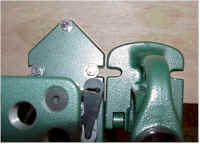 I was getting ready to disassemble and clean the press, and drill some more mount holes in the bench, when I noticed the Rock Chucker uses the same mount dimensions as the Ammo Master.
I was getting ready to disassemble and clean the press, and drill some more mount holes in the bench, when I noticed the Rock Chucker uses the same mount dimensions as the Ammo Master.
Now I would be able to mount whichever press I needed, save the bench space, and save the bench from anymore weakening mount holes. Neat. Please keep in mind I am easily impressed, and things just seemed to be working out better than anticipated.
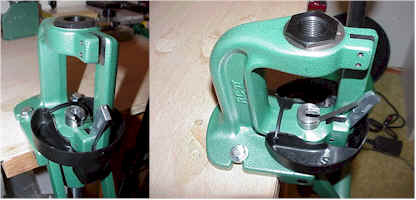
A little rat tail file work, slotting one hole about 1/4″, and 5 minutes to install the press, everything was ready to go. Gave my bench a sort of retro 70’s happening look. I removed the primer arm in the front of the press, but I may reinstall it if I have some time to play around with setting it up and actually using it. For now, I’ll stick with the APS system.
 I ran some .243 cases through the press. The die set up was the same as with the Ammo Master, and is very quick – less than minutes.
I ran some .243 cases through the press. The die set up was the same as with the Ammo Master, and is very quick – less than minutes.
I set up to run 50 cases in a batch. There were two notable differences from the auto progressive set up. I was using small base dies and the handle effort was considerably higher. The lever connecting the handle on the Ammo Master offers much greater mechanical advantage.
The Rock Chucker feel is much more positive, precise. The Ammo Master has a little mush in it, probably the result of all the sandwiched moving parts compressing.
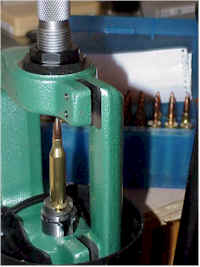 Bullet seating was a lot different. It was nice to be able to concentrate on one step and not have to worry about several other steps going on at the same time, if powder wasn’t dispensing properly, or is a primer got picked up by the shuttle.
Bullet seating was a lot different. It was nice to be able to concentrate on one step and not have to worry about several other steps going on at the same time, if powder wasn’t dispensing properly, or is a primer got picked up by the shuttle.
I took my time, sizing and decapping on the press, trimming and charging off the press, and final bullet seating on the press.
It took a little over an hour to finish up 50 rounds. Maybe that would get better in time, but the single station press does not create a loading environment that is conducive to volume loading. I didn’t mind at all.
I did check all cases for concentricity, COL and verified every 10 cartridges for powder charge. Bullets never moved beyond .003″ off centerline, overall length was within .001″ maybe barely .002″. Powder, Reloader 19, was fine and the bench mounted powder measure needed no adjustment throughout the process. I really liked this process and the ammo was probably the most consistent I’ve ever made.
I tried removing and installing dies to see how closely they would return to the same adjustment. I also tried using the press for different cartridges before returning to a specific set up. I couldn’t get anything to change, but maybe they would over an extended period of time. It is so much faster change over the Rock Chucker compared to the Ammo Master.
I would not use this approach for pistol ammo, or moderate capacity rifle cartridges. I’m sure I will follow the guidelines I noted at the beginning of this piece to select cases for either process. Next week, back to the range.
Thanks,
Joe

Email Notification